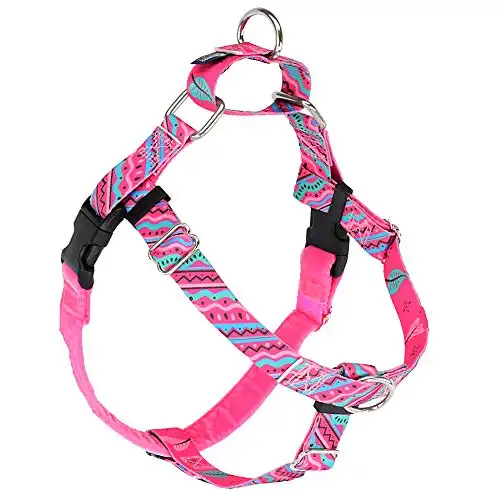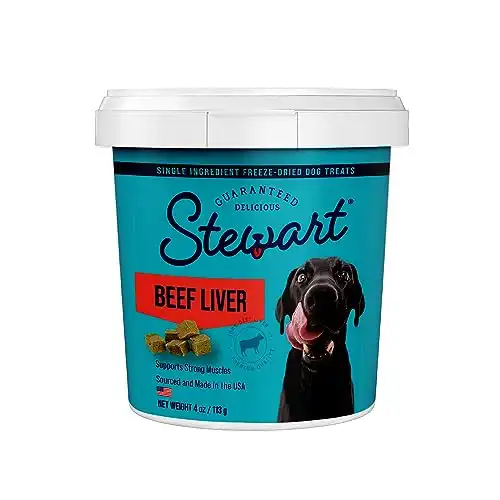Helping dogs have more fun with their humans!


Are you looking to provide your furry friend with a safe and comfortable way to explore the great outdoors? Look no further than harness training! Using a harness instead of a traditional collar and leash ensures your beloved pet remains secure and comfortable during those long walks or adventurous outings.
In this article, we will delve into the benefits of harness training and how to harness train your dog. It’s amusing when someone else is chasing their dog around their home while trying to put on a harness, but it’s not nearly as fun when you’re the one doing it. Let’s get into it!
Benefits to harness training your dog
Whether you have a small, energetic puppy or a large, strong dog, harness training can help you maintain control of your pup, ensuring a safer and more enjoyable experience for both you and your furry friend. So, if you’re looking for a way to enhance your pet’s safety, comfort, and control during outdoor adventures, harness training is the way to go. Let’s explore all the benefits together!
More challenging for your dog to escape
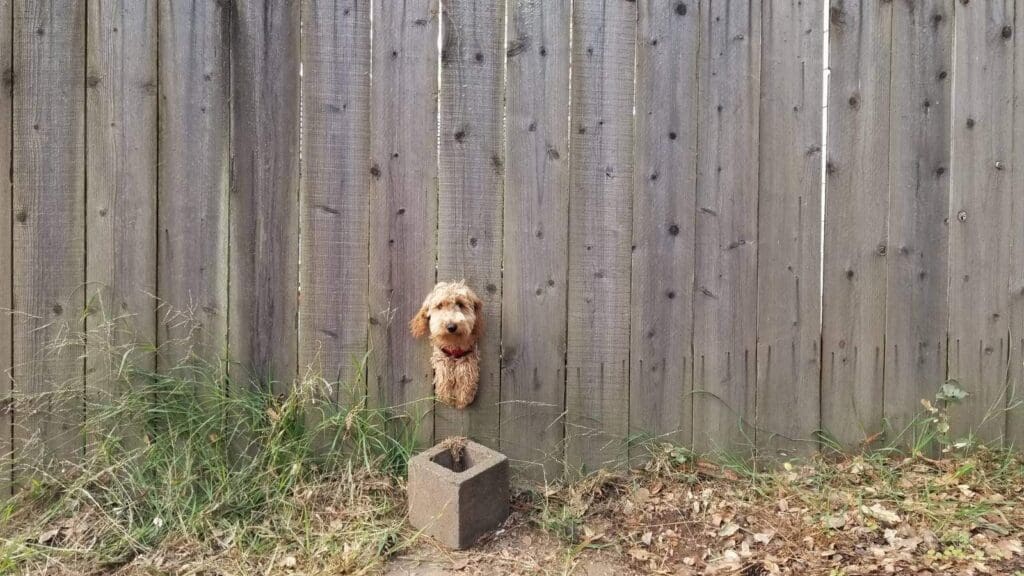

Enhanced safety for your furry friend is perhaps the most obvious advantage of training your dog to use a harness. When properly adjusted, harnesses are significantly more secure than traditional collars, making it much more challenging for your pup to escape.
It is surprisingly easy for a dog to slip out of a collar, even if it is adjustable like a slip or martingale collar. Certain dogs, like our Goomba, have proportions that make it nearly impossible to prevent this from happening. In Goomba’s case, his head and neck are almost the same size, which means that if the collar can slide onto his neck, it can also slide off his head.
It helps avoid (or deal with) an injury
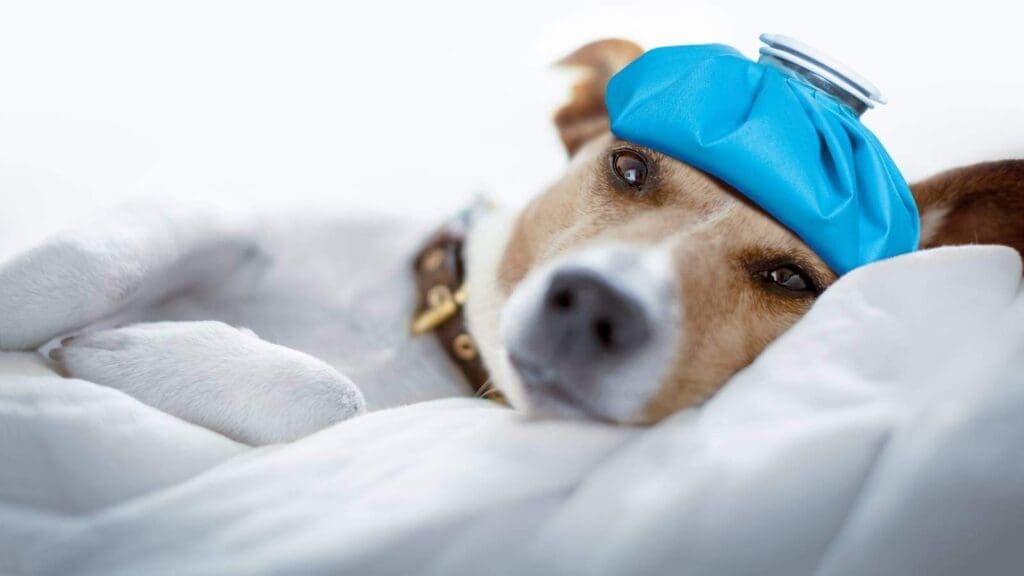

Some dogs aren’t able to use a traditional collar due to issues with injuries. For example, if your dog has tracheal issues or has had a bump removed from the region their collar could touch, you’ll have to find an alternative way to keep them secure, such as the 2 Hounds Design Freedom Harness (Amazon).
This is Prim's favorite harness, by far! It's secure, offered in a ton of colors, and affordable for a dual-clip setup. We love the option of having both front and back clip points. Prim has sensitive skin and this is the most gentle harness we've found for her so far. We've had it for years and wash it frequently and haven't had any issues at all!
- Easily adjustable to work for all sizes of dogs
- Wide opening makes it easy to put over your dog's head
- Offered in a wide variety of colors & sizes
- Multiple clip points
- Neck portion has no clips for extra safety
- No handle to grab on top of harness
There’s also a natural tendency to pull up on your dog when they’re pulling at the end of their leash or reacting. This can lead to a whole host of issues, but if you use a harness, that weight is distributed at the bottom of the chest instead of around the neck. The bottom of the chest is a much safer spot for your pup to bear weight than their neck.
The same process for getting your dog acclimated to a regular harness can help your dog get used to an injury-specific harness, like a harness made for lifting. We used this same process during recovery from CCL surgery for Goomba when he was forced to use a liftable harness.
Easier to train loose-leash walking


This is our favorite benefit of harness training your pup! Utilizing a harness can greatly simplify the process of teaching your dog to walk on a leash without tension, unlike a conventional collar. Many harnesses have front clip points, which are a place to attach a leash to your dog’s chest. This proves to be incredibly beneficial as it redirects your dog’s pulling force sideways, steering them away from their intended direction. There’s more to it than just that, as the goal is to train your dog not to pull, but that’s a different topic.
Harness training is extremely beneficial for reactive dogs, such as our Goomba. By utilizing the front clip point on the harness, your dog’s reactions will be redirected, preventing them from pulling at the end of their leash. This makes it much easier to turn your pup around and remove yourself from the situation. As with loose leash walking, the goal is to avoid and eventually eliminate this reactivity as much as possible, but even the best trainers aren’t 100% with avoiding this.
Types of harnesses


When you are harness training your pup, you’ll want to make sure your harness is appropriate for what you are trying to accomplish. There are a slew of different options for harnesses for walking, but they can generally be broken down into 4 categories.
Rear clip harnesses are the most common. We’re not a fan of rear-only clips because they can encourage your dog to sled-pull unless you’ve worked on loose-leash walking. It does reduce the amount of time your dog gets tangled up with the leash better than some other options and is still beneficial for spreading the pressure around on your dog and keeping your dog secure. We use rear clips most of the time, but we’ve been reinforcing loose leash walking for years.
Step-in harnesses are generally similar to a back clip harness, except instead of putting it over your dog’s head, like a collar, it comes up from their feet to clip around the top. These have most of the same pros and cons as back clips, except for two differences. There tend to be fewer buckles, which means fewer spots to break. It also works much better for dogs who don’t like things put on over their head, but it can sometimes be tricky to get your dog to line up their feet into the harness. We’ve used this step-in harness with Prim before and thought it worked extremely well for the price.
Front clip harnesses, also known as no-pull harnesses, are constructed the same as a rear clip harness but have a place for a lead on the front of the harness. This allows easy redirection if your dog gets too excited or if your dog is pulling on their leash. The con of these is that if you use a longer lead, your dog can get the leash between their legs easily.
Dual clip harnesses are the best of both worlds, as they will have connections for both front and back clip options. These tend to be more expensive than the front or back clip varieties because they can do both. They also tend to be better made, in our experience. We personally prefer this option, and both of our pups use one. Goomba’s current favorite is from Bully Billows and Prim’s favorite is the 2 Hounds Design Freedom Harness (Chewy).
This is Prim's favorite harness, by far! It's secure, offered in a ton of colors, and affordable for a dual-clip setup. We love the option of having both front and back clip points. Prim has sensitive skin and this is the most gentle harness we've found for her so far. We've had it for years and wash it frequently and haven't had any issues at all!
- Easily adjustable to work for all sizes of dogs
- Wide opening makes it easy to put over your dog's head
- Offered in a wide variety of colors & sizes
- Multiple clip points
- Neck portion has no clips for extra safety
- No handle to grab on top of harness
We have a review of Prim’s favorite harness, the 2 Hounds Design Freedom Harness (Chewy). Check it out the review here, it has a wider collar portion than most harnesses so it’s a perfect option to use if you’re starting harness training!
How to harness train a dog


Harness training is generally pretty straightforward unless your pup already has a negative association with a harness from a previous event or behavior. If that is the case, take these steps slower than recommended as it will take more effort to change a negative association into a positive one than it would for a neutral association to become positive.
Harnesses with a wider opening, such as Prim’s favorite by 2 Hounds Design Freedom Harness (Chewy), are much easier to harness train with than ones with a smaller collar opening. If you have a no-pull dog harness for training that has a smaller opening, don’t worry! It’s still possible, it may just take a little extra work to get your dog used to it compared with a wider one.
Also, if you shop on Amazon for pet supplies, here’s the link for the 2 Hounds Design Freedom Harness on Amazon.
Taking treats when the harness is nearby
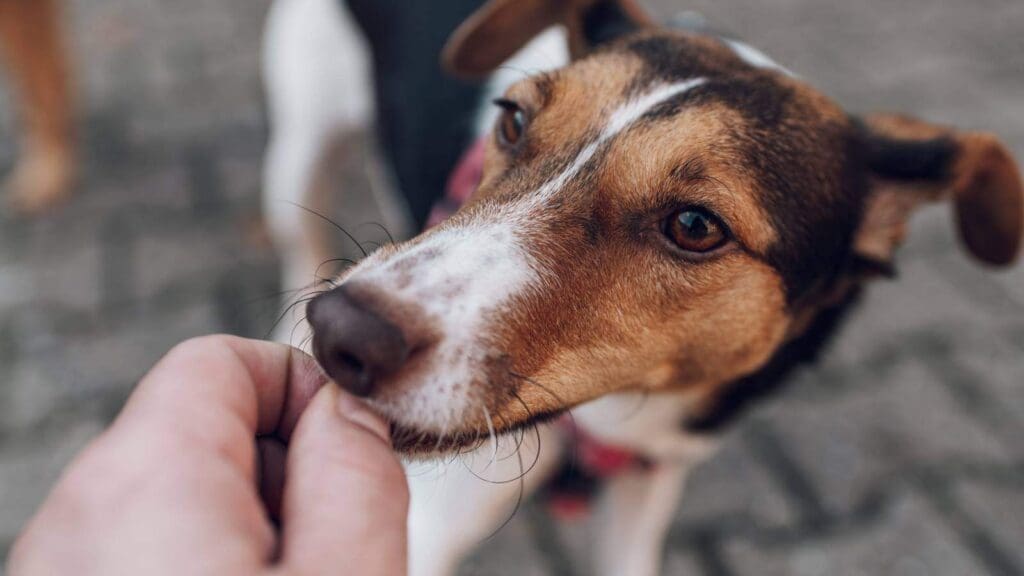

Similar to our guide on muzzle training your dog, the first step is for your dog to take treats when the harness is near them.
Put the harness on the ground & grab some of your pup’s favorite treat or toy. Next, reward your dog for being near the harness or for doing some basic obedience work near it. Our pups both love the Stewart beef liver bites They’re (relatively) low calorie, last a long time, and taste great, according to our dogs.
This is our (and our pups') favorite choice for beef liver! It's cheaper than a lot of other options and they go crazy for it! It's possible to cut it into smaller pieces to make it last longer.
If your pup has had a negative experience with a harness before, start with the harness as far away as needed and work toward getting it closer. This step will end when the harness is less than a foot from your pup.
Taking treats from the harness


After your dog is comfortable (or enjoys) having the harness nearby, we’ll begin transitioning to our next step of harness training. This is Prim’s favorite step!
All you need to do is to feed your Stewart beef liver bites or kibble through the harness. That’s it! Stick your arm through the collar portion and have your pup grab the reward. Keep working with this until your pup is okay with getting the reward near the collar portion of the harness.
As your dog becomes more comfortable with taking rewards from the harness, begin working toward your dog placing their snout through the collar portion of the harness. Take this step as slowly as you need to, as a lot of dogs don’t like the small entrance of the harness. We want your pup to think the harness is a treat dispenser, not a restraining device.
After your pup is putting their snout into the collar portion consistently (9 out of 10 times), move to the next step.
Putting the harness on & taking it off
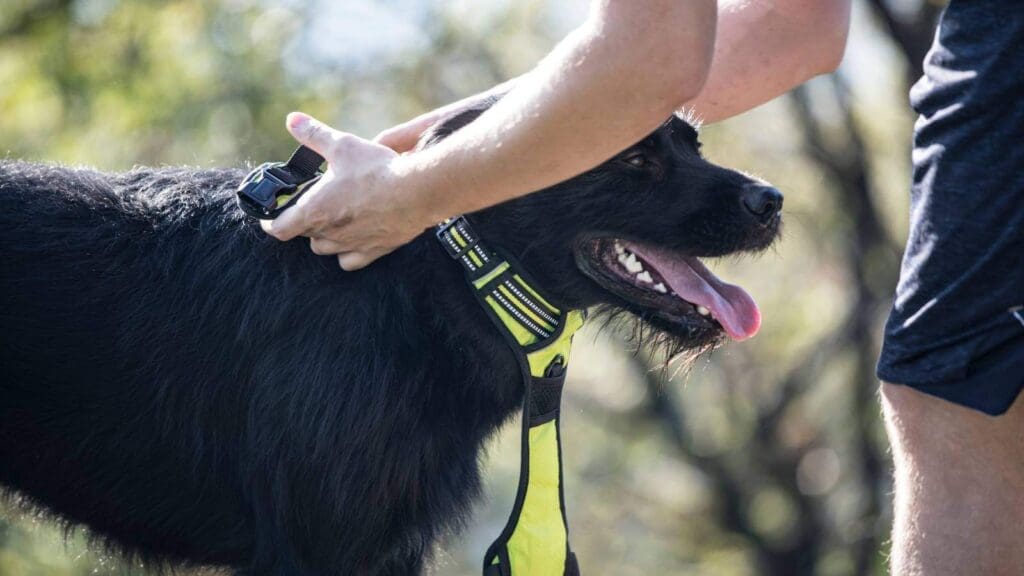

You’ll want to use your progress from the last step when your pup shoved their snout into the harness for a treat with one difference. Once they put their snout through, put the harness on your pup. We recommend not having the leash attached initially & having the collar portion of the harness as wide as possible, even if that isn’t how you plan on using it. This will give you the highest chance of success and make your pup the most comfortable with the harness.
This is Prim's favorite harness, by far! It's secure, offered in a ton of colors, and affordable for a dual-clip setup. We love the option of having both front and back clip points. Prim has sensitive skin and this is the most gentle harness we've found for her so far. We've had it for years and wash it frequently and haven't had any issues at all!
- Easily adjustable to work for all sizes of dogs
- Wide opening makes it easy to put over your dog's head
- Offered in a wide variety of colors & sizes
- Multiple clip points
- Neck portion has no clips for extra safety
- No handle to grab on top of harness
We recommend rewarding your pup after the harness is sitting on them unclipped for one second. Gradually work your way up to both buckling it and increasing the duration. As with the previous step, starting on the loosest setting will give you the highest chance of success.
This step can be frustrating if you rush it, so if you or your dog gets frustrated, take a break and go back to the previous step. Remember to take it slow.
If your dog needs an additional step between the previous step and this one, you can also hold the harness behind their ears and then remove it.
Before taking your pup outside with their harness, we recommend doing some indoor obedience work, food-based enrichment, or playtime to continue to acclimate your pup to the harness. If you need some ideas, check out our favorite games to play with our dogs inside! Some of our favorites are frozen Kong recipes, frozen lick mats, the “other side” command, or frozen Toppls. If your pup is more prey-driven, try a DIY flirt pole!
Walking with the harness


We wanted to give a few tips and tricks for things to pay attention to when you start walking with a harness. This won’t be a step-by-step guide for how to teach your dog to loose leash walk but should help provide a starting point.
The tendency for most pups is to want to sled-pull with a rear clip harness. If at all possible, avoid this happening from the beginning. The easiest ways to deal with this are to either use a front clip location or to turn around whenever your dog starts pulling. Turning around removes their reward for pulling which is getting close to whatever object they were pulling toward. This process was extremely effective in teaching Goomba not to pull.
Make sure your harness is fitted properly. An improperly fitted harness is fine while you’re harness training your dog, but it’s trouble when you go outside with it. It’s easy for a dog to escape a harness that is way too loose and you’d be surprised with how easily they can get out of it.
Finally, remember to be patient with your dog! They are acclimating to wearing a much more involved piece of equipment than a collar. It’s easier and less stressful for you and your dog to take it slow and do it right than it is to try to break a negative association with a piece of gear.
Conclusion
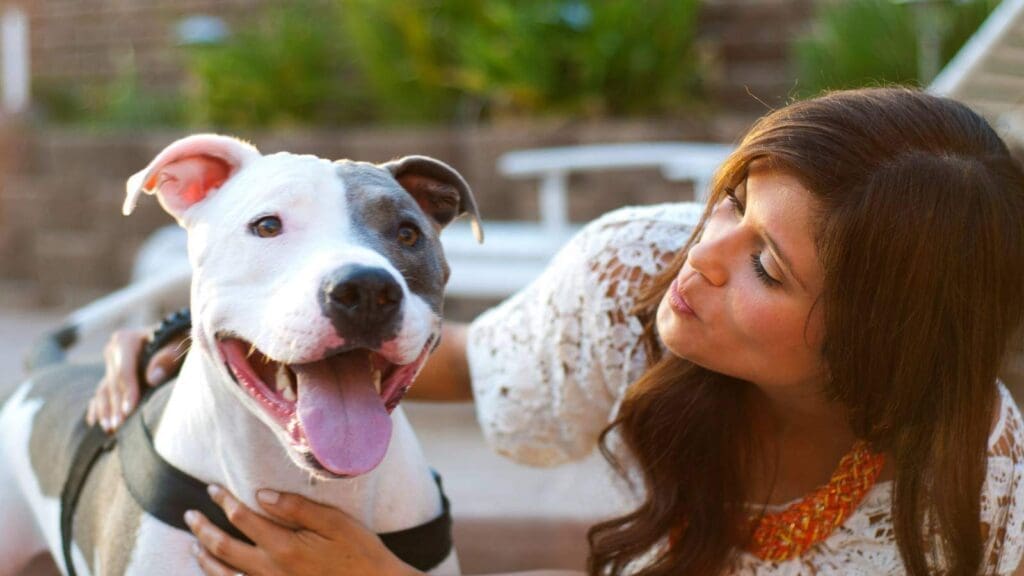

Harness training your dog doesn’t have to be frustrating or difficult! If you do your best to stay patient and positive, your dog will learn the behavior quicker and it will be more fun for both you and your dog.
Did you do your harness training a different way? Share your photos of your dog trying out a harness with us on Instagram by tagging @therulybully.
Have fun!
